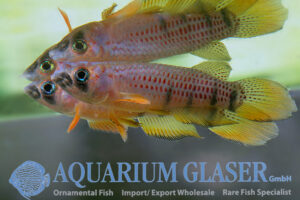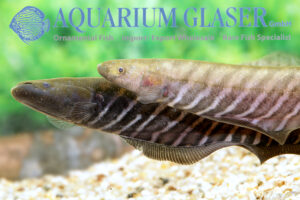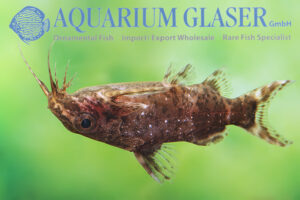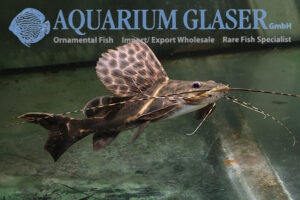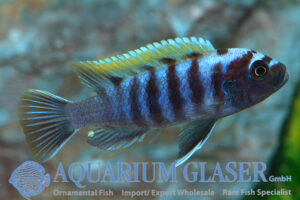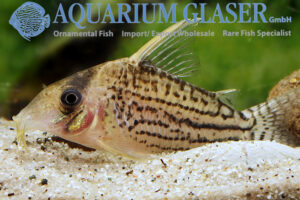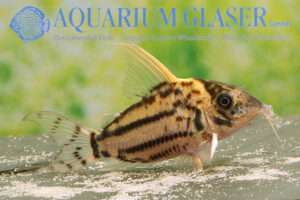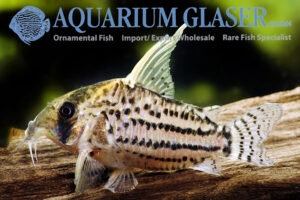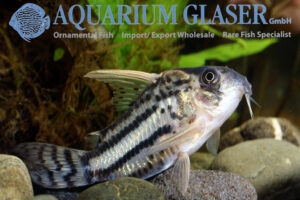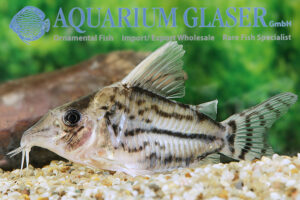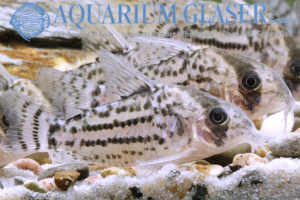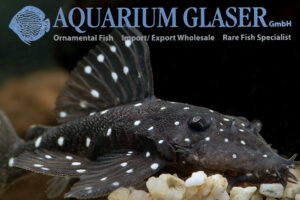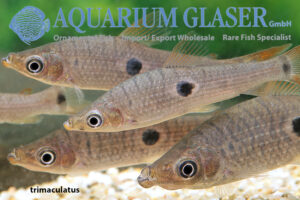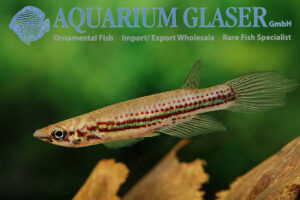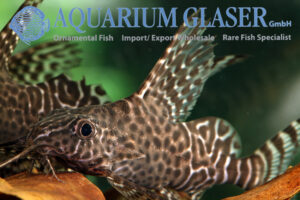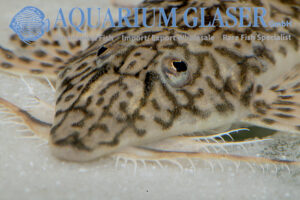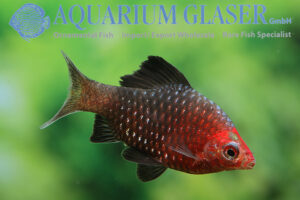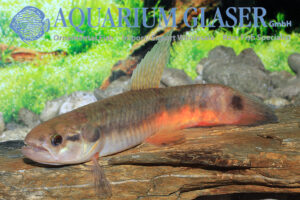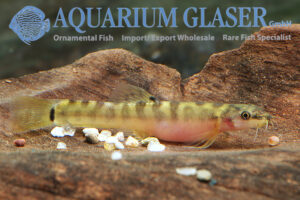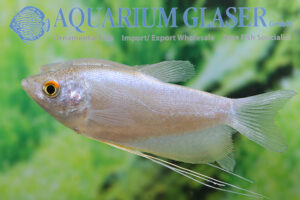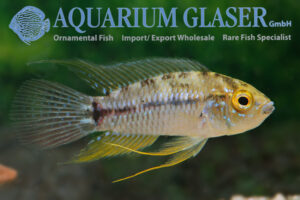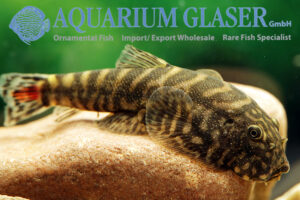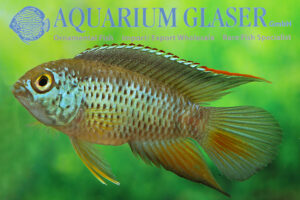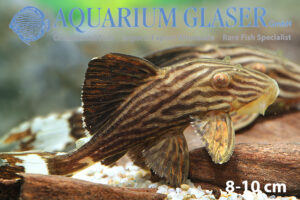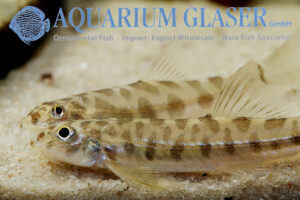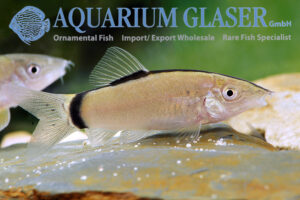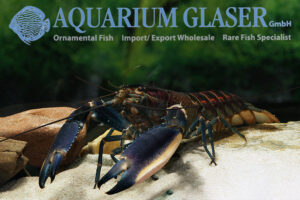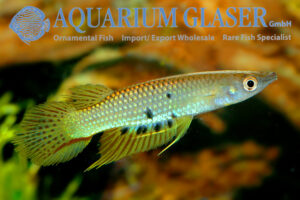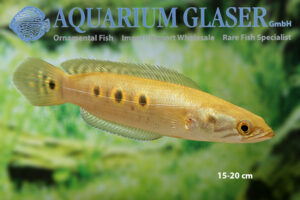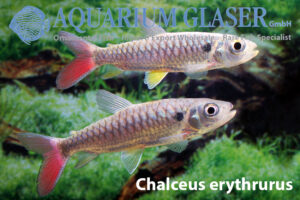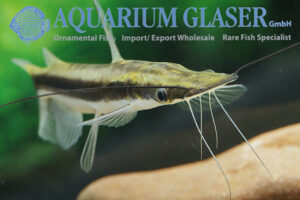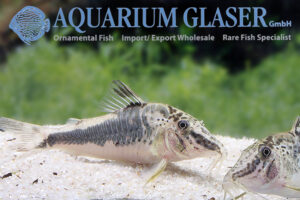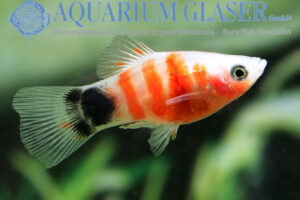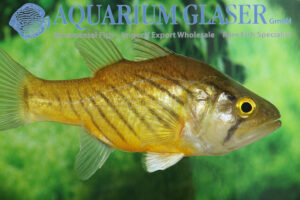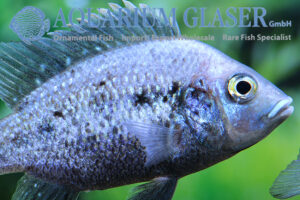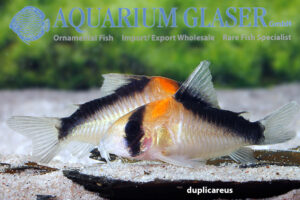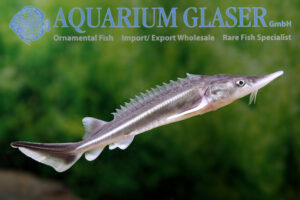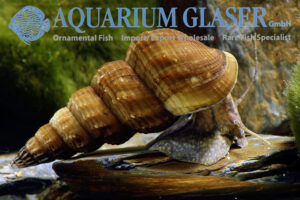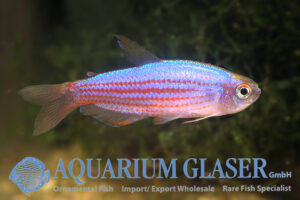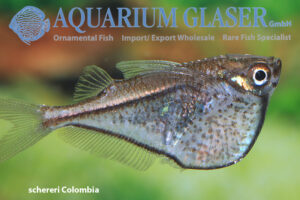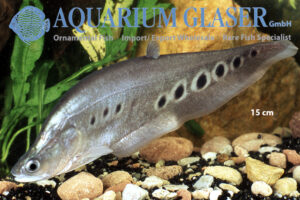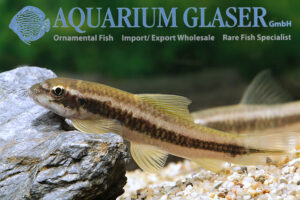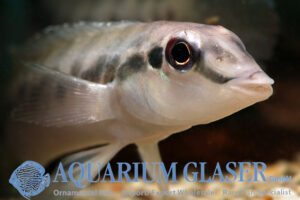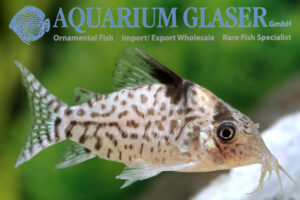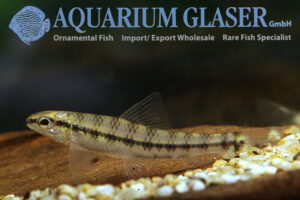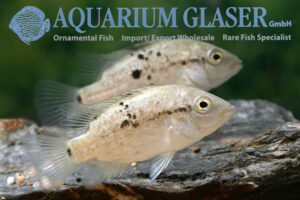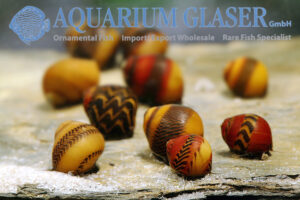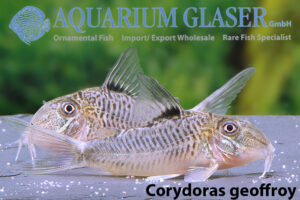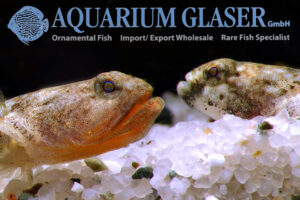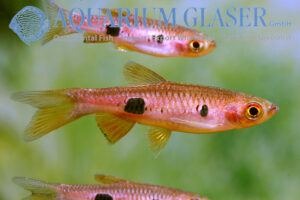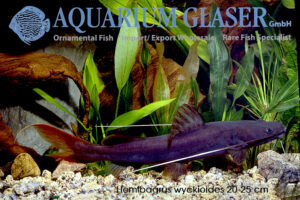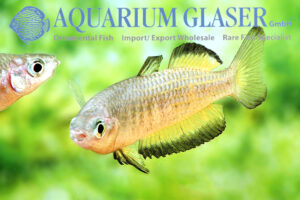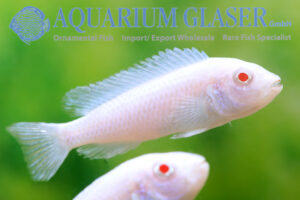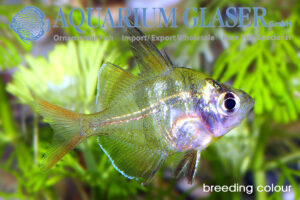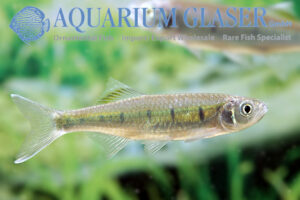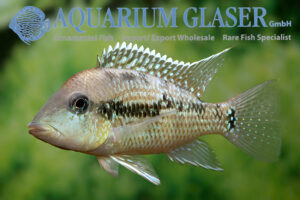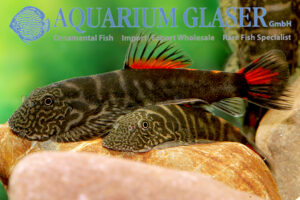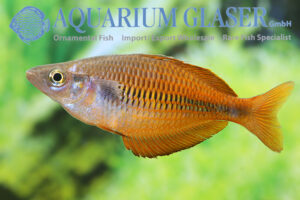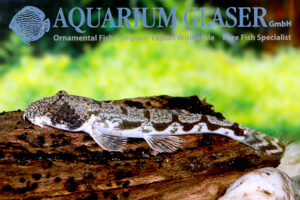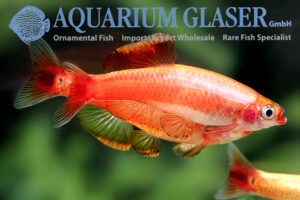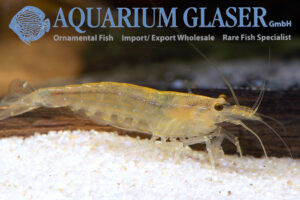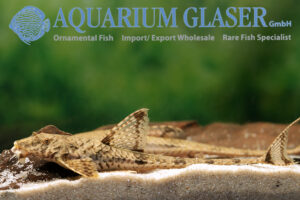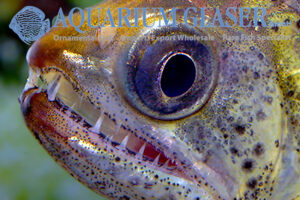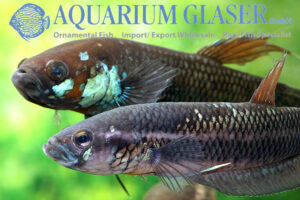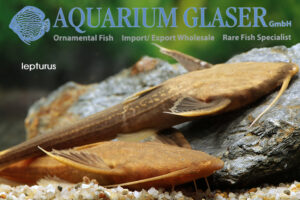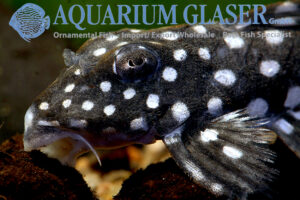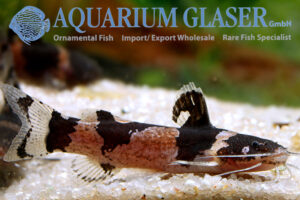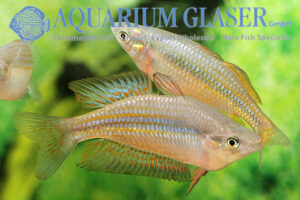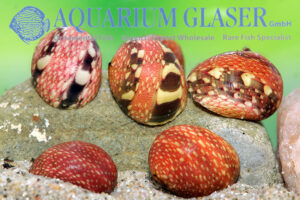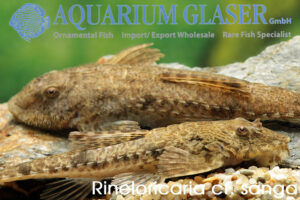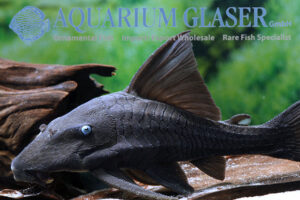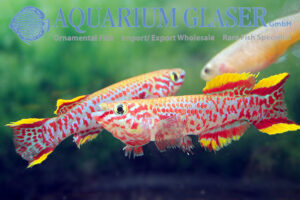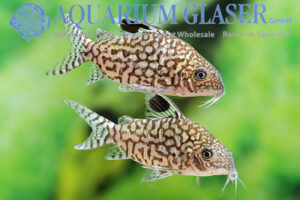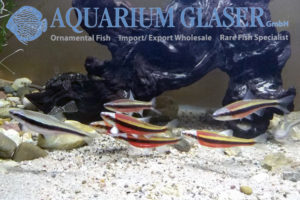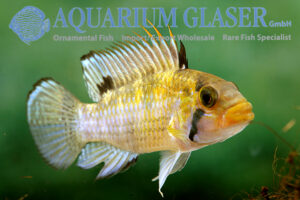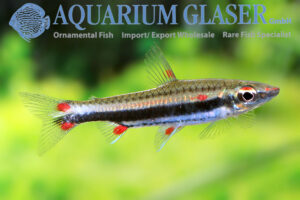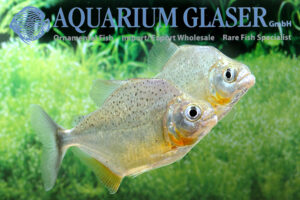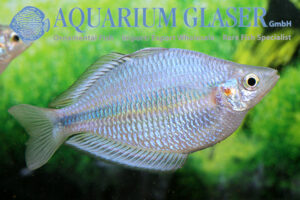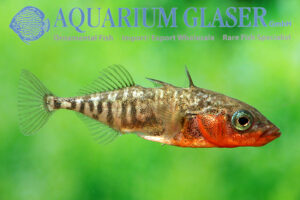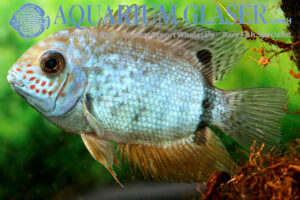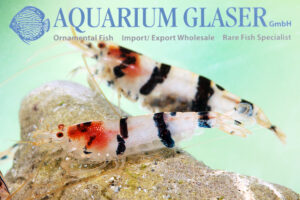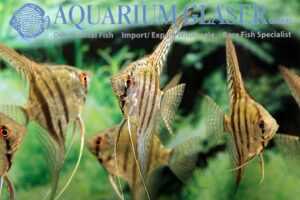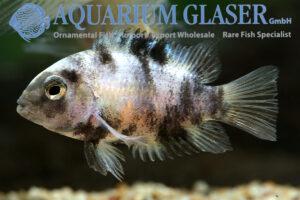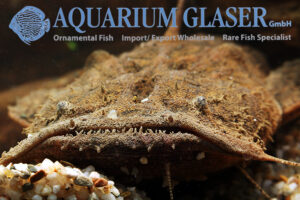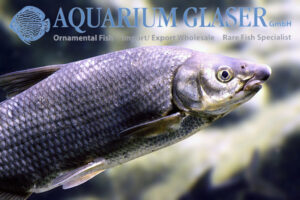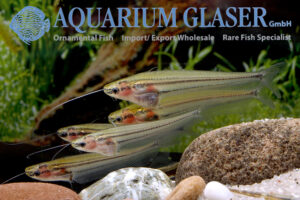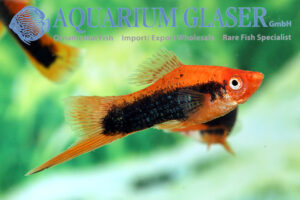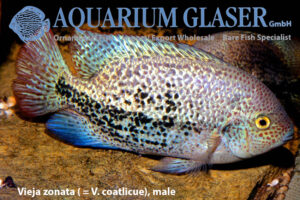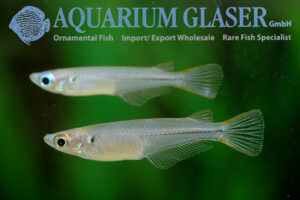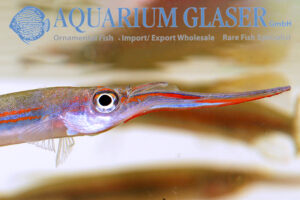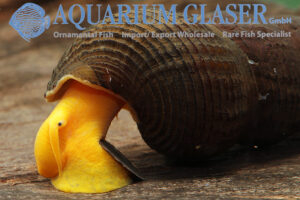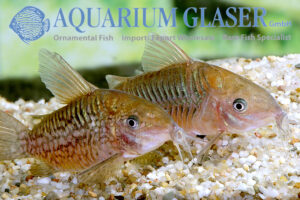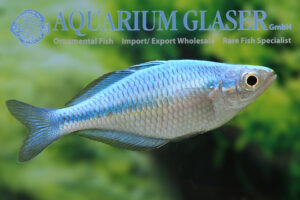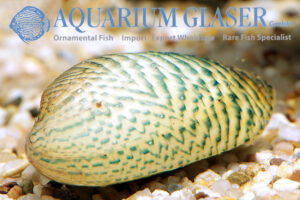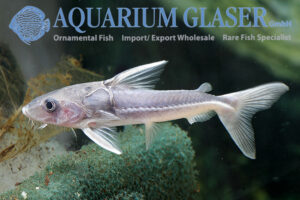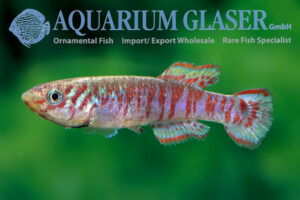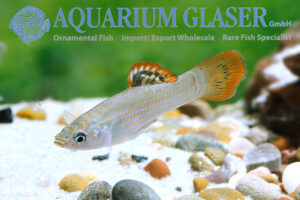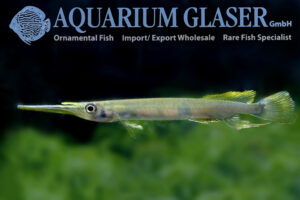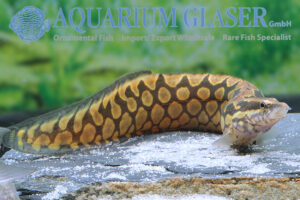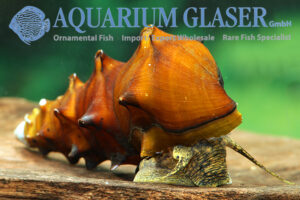The panchaxes of the genus Epiplatys are species-rich in tropical Africa. In the most recent scientific overview by Huber (2024), 54 species are recognized. Only two of these species are regularly found in the trade, namely E. annulatus (clown killifish) and E. monroviae (red chinned panchax, this species was previously regarded as a subspecies of […]
Fish Archive (3089)
-
-
Gymnotus carapo occidentalis
The banded knifefish (Gymnotus carapo) is one of the first species to be recorded in modern science and was described as early as 1758. It has – according to traditional opinion – an enormously wide distribution in South America, but one should bear in mind that many earlier reports of the species are probably based […]
-
Synodontis nigriventris
By far the most popular squeaker catfish (Synodontis) is the upside-down catfish (Synodontis nigriventris). The species comes from the Congo, where it colonizes the central section of the river (including Pool Malebo, the former Stanley Pool); the settlement area also includes the basins of the Kasai, Ubangi and Kouilou-Niari rivers. It is not the only […]
-
Leiarius pictus
Leiarius pictus is one of the most attractive predatory catfish of all. The large, sail-like dorsal fin in combination with the light-colored band that starts at the base of the dorsal fin and runs diagonally backwards to the belly make it unmistakable. The species is extremely widespread in South America. It has been reported from […]
-
Maylandia emmiltos
The very first Lake Malawi cichlids came from the group of rock-dwelling cichlids, called Mbuna after a local name, in the late 1950s and early 1960s, including a fish identified as Pseudotropheus zebra in 1964. Today we know dozens of species from this zebra complex, which are often only distributed very locally, but sometimes also […]
-
Brochis sp. “Super Schwartzi Hifin Longnose” ( = Corydoras sp. “labrina” or “labrea”)
The characteristics of Brochis sp. “Super Schwartzi Hifin Longnose” are identical to Hoplisoma sp. “Super Schwartzi Hifin CW28”, except that Super Schwartzi Hifin Longnose is a longnose and Super Schwartzi Hifin CW28 is a roundnose. Brochis sp. “Super Schwartzi Hifin Longnose” has usually only appeared in single specimens mixed with the other species from the […]
-
Brochis sp. “CW28 Longnose” ( = pulcher variant)
The characteristics of Brochis sp. “CW28 Longnose” are identical to Hoplisoma sp. “CW28”, but Brochis sp. “CW28 Longnose” is a longnose, CW28 a roundnose. This species is usually sent mixed with CW28, but occasionally also mixed with Brochis pulcher. We have often received this species purely sorted as Brochis pulcher. In the aquarium literature, Brochis […]
-
Hoplisoma sp. “Super Schwartzi Hifin CW28”
The characteristics of Super Schwartzi Hifin CW28 are: Round snout; two thin longitudinal bands, sometimes resolved to dots, running parallel, one above and one below the midline; usually two more thin longitudinal bands are present, so usually four in total; the dorsal fin spine is conspicuously cream-colored; the dorsal fin is conspicuously high in males […]
-
Hoplisoma sp. CW28 ( = cf. pulcher)
The characteristics of CW28 are: Round snout; two broad, parallel longitudinal bands on the bony plates, one above and one below the midline; the dorsal fin spine has a conspicuous cream color. The maximum length is 6-6.5 cm (standard length without caudal fin). CW28 has been known in the hobby since the 1960s. A specimen […]
-
Brochis pulcher
The Rio Purus is one of the major tributaries of the Amazon. Its length is over 3,200 km. The source and upper reaches of the Rio Purus are in Peru, the middle and lower reaches are in Brazil. The Rio Purus is home to numerous ornamental fish, including various armored catfish. A species flock of […]
-
Hoplisoma schwartzi (= Corydoras schwartzi)
This well known, but still beautiful Hoplisoma originates from the Rio Purus system in Brazil. It was named in honor of the exporter Willy Schwartz. In Hoplisoma schwartzi, which belongs to the stocky, round-headed members of the genus, the dorsal fin is marked very slightly differently in each animal, the coloration of the spine ranges from […]
-
Ancistrus sp. L107
One of the most beautiful Ancistrus of all is certainly L107, which – as far as we know – has still not been scientifically studied. It is a pitch-black Ancistrus with snow-white spots, which is also known as the “brilliant Ancistrus” due to its striking contrast. In contrast to many other similar Ancistrus, this species […]
-
Pseudanos trimaculatus
The genus Pseudanos was separated from Anostomus in 1980 due to numerous differences in the skeleton. At that time, the scientist in charge, Richard Winterbottom, assigned two already known species to the new genus – P. gracilis and P. trimaculatus – and another, which he described as new: P. irinae. The differences between P. trimaculatus […]
-
Epiplatys chevalieri
A killifish jewel reached us from the central Congo: Epiplatys chevalieri. Although this species was introduced into the aquarium hobby as early as 1950 and was even given a popular name (German: Zierhechtling, which means ornamental panchax) at the time, which is by no means common for killifish, it has not become established on a […]
-
Synodontis eupterus
Synodontis eupterus inhabits the White Nile, the Niger and Chad basins and the Volta River. There it is found over mucky and sandy substrate. Nowadays, however, practically all animals in the trade are captive-bred. A striking feature of this catfish, which can grow up to 25 cm long, is its magnificent dorsal fin with elongated […]
-
Rhadinoloricaria andaki
It’s been a while – April 2016 – since we were able to proudly report the first import of a Rhadinoloricaria species from Venezuela. Although the genus was already described in 1974, the only species assigned to it in 2016, R. macromystax from Peru, is considered to be very rare. Since our first import, the […]
-
Pethia nigrofasciata
The black ruby barb (Pethia nigrofasciata) is one of the most popular ornamental fish of all. This beautiful fish, which grows to around 5-6 cm long, is endemic to Sri Lanka (i.e. only found there). There, the species prefers to colonize flowing waters in the southwest of the island, from the catchment areas of the […]
-
Erythrinus sp. Madre de Dios
This magnificent Erythrinus comes from the drainage of the Madre de Dios, which is around 1,100 km long, lies between Bolivia and Peru and is the largest tributary of the Rio Madeira. The genus Erythrinus is in great need of revision. Nobody knows how many species there are and how they can be distinguished from […]
-
Schistura notostigma
With one of our first Sri Lanka imports of wild-caught fish after a long time, we also received Schistura notostigma. Until recently this species was thought to be the only Schistura species from the island, but recently two other species have been described from there, S. madhavai and S. scripta. The easiest way to distinguish […]
-
Trichogaster microlepis ( = Trichopodus microlepis)
Fish for romantics – does that exist? Occasionally! One of them is certainly the moonshine gourami, Trichogaster microlepis. Its popular name says it all. Although the animal is only silvery-white, its tiny scales give it a very peculiar appearance, as if wrapped in silk. Color always means: communication with conspecifics and bright colors are very […]
-
Apistogrammoides pucallpaensis
The dwarf among the little ones: Apistogrammoides pucallpaensis from the upper Amazon in Colombia and the Rio Ucayali in Peru is one of the smallest cichlid species of all. We obtain our animals from Peru. In the literature, the maximum sizes given are 5 cm for males and 4 cm for females. However, these must […]
-
Gastromyzon sp. SK2 Red Tail
Recently we were able to introduce you to the new Gastromyzon “Bloody Mary” (one of our readers recommended calling it “Lamandau” after the collecting area): https://www.aquariumglaser.de/en/fisharchive/gastromyzon-sp-bloody-mary-2/ As mentioned in the above post, we have received further species, a “Red Tail” and a “Bluel”. The “Red Tail” has been known in the hillstream loach community for […]
-
Nannacara anomala
Here’s another animal from the “been in the aquarium forever but still beautiful” department! Nannacara anomala, the Golden Dwarf Cichlid from Guyana, has already delighted our grandfathers. We currently have exorbitantly colored animals in stock, which we call “Red”. They come from a breeder who has really put a lot of love and ambition into […]
-
L27 Xingu Panaque cf. armbrusteri
The fine systematics of the large (over 30 cm) black-striped Panaque is still only unsatisfactorily studied. Panaque nigrolineatus (L190) from Colombia and Venezuela is certainly the best known by name, and in 2020 a subspecies, usually rather spotted, was described from the upper Rio Guaviare in Colombia (P. n. laurafabianae, L330 see https://www.aquariumglaser.de/en/10-catfishes/l330-scientifically-described-panaque-nigrolineatus-laurafabianae/). Aquarists recognized […]
-
Nemacheilus corica
Amongst the many species* of loach (mainly the genera Nemacheilus and Schistura, but there are more genera) that exist in India, one in particular has proven itself as an aquarium fish: Nemacheilus corica. There are many reasons for this: it remains small (5-6 cm), is peaceful, looks nice, eats all common ornamental fish foods, is […]
-
Yasuhikotakia morleti
What the armored catfish (Corydoras & Co.) are in a South American tank, the clown loaches (Botia & Co.) are in an Asian tank: interesting, beautiful and lively bottom fish. However, much more species knowledge is required for Botia than for armored catfish to avoid unpleasant surprises. Some species, such as the popular true clown […]
-
Cherax warsamsonicus (= sp. Hoa Creek)
A species of Cherax that is quite popular in the hobby for at least a decade (we are aware of imports since 2008) is Cherax sp. „Hoa Creek“, sometimes also called C. sp. „Irian Jaya“ or C. sp. „Red Coral“. The exact origin of these crayfish was totally unknown. They appeared in the market often […]
-
Aplocheilus dayi
The striped panchax (Aplocheilus lineatus, see https://www.aquariumglaser.de/en/18-toothcarps-killis-and-livebearers/aplocheilus-lineatus-wild-2/) from southern India is one of the most popular aquarium fish thanks to its splendid colors, easy care and breedability. It has only one disadvantage: at around 10 cm in length, it does grow quite large. A close relative of the striped panchax from Sri Lanka – the […]
-
Channa pleurophthalma
We regularly have perhaps the most beautiful snakehead fish in stock: Channa pleurophthalma. This species, which is found on the Greater Sunda Islands of Sumatra and Borneo and inhabits lakes and rivers there, grows to around 40 cm in length. In contrast to most other snakeheads, they like to swim a lot in open water. […]
-
Chalceus erythrurus
Traditionally, a distinction is only made between two Chalceus species, one with a shoulder spot (C. erythrurus) and one without (C. macrolepidotus). The species with the shoulder spot has yellow ventral fins when sexually mature, at least the females. This classification has often led to confusion in the trade, as there are clearly more color-distinguishable […]
-
Sorubim lima
The large-sized species of the spiny catfishes (Pimelodidae) belong as adult fishes to the desired food fishes and not less desired species for fans of predatory catfishes with giant aquariums. As juveniles, these animals often look completely different and have, for example, absurdly long fin processes. The Shovelnose catfishes of the genus Sorubim are with […]
-
Corydoras semiaquilus
Three magnificent Corydoras species from Peru undoubtedly form a closely related group. They are very pointed-headed and comparatively large (around 6 cm, sometimes up to 8 cm) Corydoras, namely C. fowleri, C. coriatae and C. semiaquilus. The independence of C. coriatae is often doubted, as numerous locality variants of C. fowleri have become known and, […]
-
Platy Bleeding Heart Mickey Mouse
Bleeding Hearts are a breeding form of the platy (Xiphophorus maculatus), which was developed in the 1940s by the famous geneticist Myron Gordon. This breeding form is a cross between a wild platy form, namely the “Ruby-throat”, which occurs in the Rio Jamapa (Gordon collected his original strain near Veracruz) and in the Rio Papaloapan […]
-
Glossamia wichmanni
The mouthbrooding freshwater cardinalfish (Glossamia) are particularly rich in species on New Guinea. Of the total of 11-12 currently accepted species, 10-11 occur on New Guinea, 9-10 even only exist there. Only one species is known exclusively from Australia and another occurs on New Guinea and in Australia, namely G. aprion (see https://www.aquariumglaser.de/en/25-perchlike-fishes/glossamia-aprion-2/) Probably the […]
-
Ptychochromis oligacanthus
The Red List of endangered animal and plant species is getting longer and longer. The cause is almost invariably the destruction of the natural habitat. In the case of freshwater fish, species with a small distribution area are always particularly endangered. In addition to factors such as environmental pollution, deforestation and water extraction for agriculture, […]
-
Hoplisoma adolfoi and H. duplicareus (formerly: Corydoras)
We receive these beautiful armored catfish both as captive-bred and wild-caught specimens. Both are currently classified in the genus Hoplisoma. The correct species identification of these animals is still unclear. There are clearly two types, a high-backed one with a very broad dorsal band (duplicareus) and a slimmer one with a narrow dorsal band (adolfoi). […]
-
Acipenser ruthenus
The sterlet, Acipenser ruthenus, is one of the smallest sturgeon species. Nevertheless, this fish can also grow to over one meter in length. The largest known specimen is reported to be 125 cm long. Sterlets become usually around 60 cm long. Like all sturgeons, this species is highly endangered due to overfishing and, above all, […]
-
Brotia herculea
The specific name „herculea“ says it all: it is loaned from Hercules, the divine hero of the Greek mythology who had enormous powers. This snail attains a length of almost 10 cm! So the common name „Giant Tower Cap Snail“ is more than justified. The snail occurs naturally in Burma and Thailand where it inhabits […]
-
Coming soon: Inpaichthys parauapiranga
Only a short time after this wonderful new tetra has been given a name can we (almost) offer it. Inpaichthys parauapiranga was scientifically described in February 2024. Peter and Martin Hoffmann have successfully bred it and we will soon be able to offer these offspring. We are already looking forward to it! They are peaceful […]
-
Black-winged dwarf hatchets, Carnegiella marthae and C. schereri
There are two species of black-winged dwarf hatchets in South America. These cute fish only grow to around 3 cm in length. According to scientific data, both species are very widespread (Brazil, Ecuador, Colombia, Venezuela, Bolivia and Peru), Carnegiella marthae has been described from Venezuela (Caño de Quiribana, near Caicara) and C. schereri from Peru […]
-
Chitala ornata
The Asian knifefishes were long known to aquarists as Notopterus species. The American scientist Tyson Roberts revised the Afro-Asian knifefishes (Notopteridae) in 1992 and used the generic name Chitala Fowler, 1934, for the high-backed Southeast Asian knifefishes, also known as thousand-dollar fishes. Only the relatively flat-backed Asian species remain in Notopterus. The actual thousand-dollar fish […]
-
Garra ceylonensis
After 10 years we once again have the sucker barb Garra ceylonensis on offer. This species is endemic to Sri Lanka, so it only exists there. Wild fish from Sri Lanka may only be exported with a special permit. Our suppliers of ornamental fish from Sri Lanka had not previously applied for this permit because […]
-
Teleocichla preta
The cichlids of the genus Teleocichla are very closely related to Crenicichla. They remain relatively small, the T. preta discussed here is one of the largest species with a maximum length of 15 cm. The swim bladder is greatly reduced in Teleocichla. Without active swimming movements, they cannot stay afloat. Ecologically, the Teleocichla could be […]
-
Corydoras ambiacus (now: Brochis ambiacus)
Corydoras ambiacus is one of the longest known species of the enormously diverse armored catfish, which has recently been assigned to the genus Brochis in a major review of armored catfish. The species Corydoras ambiacus was formally described from the Rio Ambyiacu in Peru as early as 1872. At that time, only 5 Corydoras species […]
-
Characidium steindachneri
With 97 described species, 67 of which are considered to be valid by the majority of scientists, the bottom-dwelling ground tetras (Characidium) are extremely species-rich. Unfortunately, there is no complete overview of the genus. Misidentifications or at least uncertainties prevail in both scientific and hobbyist literature. One of the most frequently cited species in the […]
-
Nandopsis haitiensis
Although the current classification of the cichlids from Central America, formerly grouped together under Cichlasoma, has been around for a few years now, many genus names have been slow to catch on in the hobby. The main reason for this is, of course, that the large cichlids of Central America are currently only kept and […]
-
Vittina waigiensis
If there was a beauty contest between the nertine snails: the species commonly known in the hobby as Neritina or Vittina waigiensis would certainly be among the winners! This species, which reaches a shell diameter of 1.5-2 cm and has extremely variable markings, was originally described by Lesson in 1831 as Neritina waigiensis. The animals […]
-
Corydoras have been revised – “new” genus names!
The armored catfish (Callichthyidae) are a species-rich family that occurs exclusively in South America. There are two subfamilies, the callichthyid catfishes (Callichthyinae) and the corydoras-like armored catfishes (Corydoradinae). The latter are particularly species-rich. Currently (June 2024), 231 species are considered to be described, 171 of which are generally recognized as valid; in addition, there are […]
-
Schismatogobius risdawatiae
The dragonet gobies (Schismatogobius) are small species of freshwater gobies, that reach between 3 and 5 cm length. They live in small rivulets near the coast but above the tide on sandy bottoms. Here they burry themselves very fast if necessary. The larvae devolop – as far as this known – in the sea. The […]
-
Rasbora kalochroma
One of the undoubtedly most beautiful Rasbora species is R. kalochroma – and one of the most sensitive. They are typical black water fish which react very sensitively during the acclimatisation phase to increased bacteria contamination, which occurs almost inevitably in “normal” water. When we were now offered youngsters, we took advantage, because young fish […]
-
Hemibagrus wyckii and H. wyckioides
These large predatory catfish from Southeast Asia usually grow to around half a meter in length. The maximum length given for H. wyckioides is up to 130 cm and 86 kg in weight, while “only” around 90 cm is given for H. wyckii. They are important food fish and are highly prized for their excellent […]
-
Melanotaenia parkinsoni
Melanotaenia parkinsoni is one of the few species of rainbowfish that are offered relatively regularly in the trade. The home of this maximum 14 cm long, but usually much smaller animal is in Papua New Guinea, in the Central Province. There are only confirmed specimens from the Kemp Welsh River, which is sometimes also referred […]
-
Chindongo socolofi “Albino” ( = Pseudotropheus socolofi)
The question of whether an ornamental fish species is particularly popular can often be answered with “yes” if breeding forms exist. Breeding forms, whose characteristics either do not occur at all in nature or only occur extremely rarely in individual specimens, usually only arise when the natural form is bred on a large scale. The […]
-
Parambassia lala
The Indian glass perch (Parambassia lala, often placed in the monotypic genus Pseudambassis) is actually an old acquaintance (first introduction: 1905), but an incredible amount of nonsense has been and still is spread about it. For example, the rumor persists that the species is a brackish water fish. But it is not, it is only […]
-
Opsarius koratensis
Typical open water fish are very rarely kept in the aquarium. There is a simple reason for this: they are usually quite colorless. The Opsarius koratensis, which can grow to a maximum length of 10-12 cm (some sources even state 16 cm), is no exception. However, keeping these fish can still be very rewarding, as […]
-
Geophagus sp. Alto Sinu
In 2016, French aquarists in Colombia discovered a new eartheater, which they named after the place where it was found in the Rio Cauca inlet – a Rio Sinu. However, this Rio Sinu is not identical to the much larger Rio Sinu of the same name in Colombia! For the exact locality see the article […]
-
Gastromyzon sp. “Bloody Mary”
The hillstream loaches of the genus Gastromyzon have developed an enormous diversity of species on the island of Borneo. The ichthyologist Tan first analyzed this diversity in 2006 and described no less than 15 new species in his book “The Borneo Suckers”. Since then, a total of 36 species of the genus have been known […]
-
Melanotaenia fasinensis
The Bird’s Head Peninsula is part of the large island of New Guinea. It is located in the northwest of New Guinea and belongs politically to Indonesia (West Papua). For rainbowfish enthusiasts, it is currently the holy land, as the Bird’s Head Peninsula is a hotspot of diversity for this group of fish. The most […]
-
Canthophrys gongota ( = Somileptus gongota)
The moose faced loach from India is a very unusual representative of its family. Although there are many loach species that burrow, Canthophrys gongota has perfected this behavior. In its natural habitat, the rivers in the north of Bengal, it lives where the bottom is made up of fine sand. Here it likes to bury […]
-
Tanichthys albonubes Gold-Red
A new breeding form of the well-known white cloud: Gold-Red. It is very interesting that you can recognize all possible intermediate stages of the two parent forms by this not yet completely bred form: the golden white cloud, which shows mostly black pigmentation in the belly area with a basically yellowish body coloration, and the […]
-
Caridina multidentata “Yellow”
After the new breeding forms “Snow” and “Orange” (https://www.aquariumglaser.de/en/31-crayfishes-shrimps-crabs-snails-mussels/caridina-multidentata-orange-and-snow/), the Asian professional breeders have now apparently established a third color form of the Amano shrimp: “Yellow”. The yellow Amano shrimp (zoologically speaking, all Amano shrimps belong to the same species, namely Caridina multidentata) also has no care requirements that differ from the original form. All […]
-
Rineloricaria eigenmanni
There is no consensus among ichthyologists (= fish experts) as to the correct generic name for the whiptail catfish of the narrower Rineloricaria relationship. Some group all species together as Rineloricaria, others divide these fish into Rineloricaria and Hemiloricaria. Rineloricaria in the broadest sense is very species-rich, currently 64 species are recognized and there are […]
-
Hydrolycus armatus Orinoco
Once more we were able to import this breathtaking animal from the Rio Orinoco. Anyone who is interested in this species should take the chance now, because this fish is available only a few weeks each year. For more informations on the species please see https://www.aquariumglaser.de/en/09-characoids-tetra-relationship/hydrolycus_armatus_en-2/ and https://www.aquariumglaser.de/en/09-characoids-tetra-relationship/hydrolycus_armatus_en/ For our customers: the animals have code […]
-
Betta unimaculata
Modern labyrinth fish science began in the 1980s. At that time, enthusiastic labyrinth fish enthusiasts joined together to form international associations. The world opened up to travelers and areas in Southeast Asia could be visited that had previously only been known from maps. One of the first Betta species to enter the hobby at that […]
-
Xyliphius cf. lepturus and X. cf. melanurus
Once again we succeeded in importing some specimens of these strange, naturally almost blind banjo catfish, this time from Colombia. For our first import and further information see here: https://www.aquariumglaser.de/en/10-catfishes/10c-catfishes-remaining-catfish-from-south-america/xyliphius-cf-lepturus/ This time there are apparently two species in the import. Unfortunately, only one specimen probably belongs to the species Xyliphius melanopterus, recognizable by the light […]
-
Hypancistrus inspector “L102, Snowball Pleco”
L102 is one of the plecos that has long been known in the hobby and was given its L number back in 1992. These animals originated from the lower Rio Negro in Brazil and were soon given the popular name “Snowball Pleco” because of the large white spots on a black background. The species was […]
-
Microglanis “poecilus”
The genus Microglanis consists of small to very small catfish with a maximum length of between 2.5 and 8 cm, depending on the species. All species come from South America. Until 1950, only 6 species were differentiated; currently the number of species is 30, with 17 species alone being described after the year 2000. Only […]
-
Melanotaenia splendida
The second species of rainbowfish of the genus Melanotaenia that was ever scientifically described was M. splendida. This was in 1866 and the description of the species is based on specimens from the Fitzroy River in Queensland, Australia. The species seemed so unusual to Peters, who first described it, that he even created a new […]
-
Clithon sowerbianum “Pink Lady”
Like most neritine snails, Clithon sowerbianum, known as the mini neritine snail, is extremely variably colored. As early as the 19th century, a number of variants were therefore scientifically named, but these are no longer considered to be of systematic importance. However, it must be clearly stated that the identification of the 57 accepted Clithon […]
-
Rineloricaria cf. sanga
We received Rineloricaria from the Brazil-Uruguay border region. The genus Rineloricaria is extremely species-rich with currently 72 accepted species and new species are constantly being added. Unfortunately, there is no complete overview of the genus, making identification extremely difficult. The southern Rineloricaria are also particularly tricky because only a few live observations have been made […]
-
Panque suttonorum ( = P. suttoni)
In the 1980s, the blue-eyed Panque was one of the most common loricariid catfishes on the market. Incidentally, the correct name is Panaque suttonorum. For unknown reasons, the animals are hardly available nowadays. There are a lot of rumors that an environmental disaster is to blame or that a madman has poisoned the river or […]
-
Fundulopanchax gardneri nigerianus
Fundulopanchax gardneri nigerianus is one of the very few species of killifish that are regularly found in the trade. It is highly likely that many of the fish bred today still originate from the old strain from Akure in Nigeria, which was introduced to Denmark in 1957. In 1963 Clausen described Aphyosemion nigerianum scientifically on […]
-
Corydoras reticulatus
We are once again able to offer fully grown Corydoras reticulatus from Peru. C. reticulatus can be easily distinguished from the similar species Corydoras sodalis (see: https://www.aquariumglaser.de/en/10-catfishes/10a-catfishes-corydoras-co/corydoras-sodalis-2/) by the deep black spot on the dorsal fin. The maximum length of C. reticulatus is around 6-7 cm in total, including the caudal fin. The species makes […]
-
Notropis lutipinnis
The small fishes of North America are rather unknown in Europe. Yet the genus Notropis alone includes 91 accepted species! Many of them are very colorful at spawning time. In their native country Notropis species are called “shiners” in the sense of a shining object, so much do the colors of these fish shine. But […]
-
Apistogramma norberti
The 1990s were a decade in which many new dwarf cichlid species were discovered and scientifically described. This was made possible by the combination of good travel opportunities and tolerant export policies, the emerging Internet and the resulting considerably simplified global communication. Apistogramma noberti, a species from Peru that was scientifically described in 1991, was […]
-
Nannostomus trifasciatus
Sometimes you almost forget how incredibly beautiful traditional aquarium fish are due to the large number of interesting and colorful new imports. The Threestripe pencilfish, Nannostomus trifasciatus, is one of the most beautiful of them all. According to the huge distribution area of the species (Bolivia, Brazil, Guyana and Peru), there are numerous color variants […]
-
Serrasalmus eigenmanni
The systematics of piranhas is undisputedly one of the most complicated and complex sub-disciplines of fish science (ichthyology). There are several reasons for this. Piranhas are extremely common and conspicuous fish that are very easy to catch. As early as the 18th and 19th centuries, several species were described and named, often based on individual […]
-
Melanotaenia goldiei „Kafiamke“
This species of rainbowfish from Papua New Guinea was scientifically described as early as 1883. However, it was not until around 100 years later that the first specimens were introduced into aquaria outside Australia, although M. goldiei is one of the most common and widespread species in the southern part of the island. As is […]
-
Gasterosteus aculeatus
The three-spined stickleback (Gasterosteus aculeatus) is one of the species native to Europe that everyone should know and every aquarist should have kept at least once. Entire books could be written about this incredibly adaptable fish – and many have been. Nevertheless, it is still poorly understood from a purely scientific point of view. The […]
-
Heros sp. Turquoise Lago Juá
The genus Heros is in urgent need of scientific revision. The current five generally recognized species only represent a small part of the populations now known. It is often almost impossible to choose a reliable species name, which is why in many cases it is now simply omitted. They are called Heros sp. and an […]
-
Caridina haivanensis
Dwarf shrimps of the genera Caridina, Paracaridina and Neocaridina have become an integral part of the aquarium hobby. In countless wild species, color variants and cultivated forms, they delight nature lovers all over the world. It is hard to believe that these little animals were practically unknown in the hobby 30 years ago! Parallel to […]
-
Pterophyllum “Zebra”
We do not know exactly when and where the zebra scalar was bred. In his monograph on angelfish, completed in 1977 but not printed until 1979, Paepke states that he was unable to find any sources. At this time, there were already several breeding lines of the zebra scalar, whose characteristic breed feature is the […]
-
Amatitlania (formerly Cichlasoma) nigrofasciata Marble
The Convict cichlid Amatitlania (formerly Cichlasoma) nigrofasciata is no longer a novelty: it has been kept and bred in aquaria since 1939. The first aquarium specimens of this fish, which is widely distributed in Central America, came from Lakes Atitlan and Amatitlan in Guatemala. The genus to which the greenfin cichlid currently belongs was named […]
-
Chaca chaca
These catfish have their funny name due to the fact that they make croaking sounds when taken out of the water. These sounds are decribed onomatopoeicly as „chaca“ by the natives. Usually Chaca chaca is imported from Bengal; the species is pretty common, but only seldom available, as it is not eaten by the local […]
-
Chondrostoma nasus
The nase (Chondrostoma nasus) is a carp fish, usually 25-30 cm, maximum 50 cm long, which is native to Central Europe and Western Asia. As the species has relatively high demands on water quality, populations have declined sharply in many places, but the nase is currently considered „least „concern“ overall. Unfortunately, nase has also been […]
-
Kryptopterus macrocephalus
This close relative of the well-known and popular glass catfish Kryptopterus vitreolus (formerly: K. bicirrhis) is widespread in Southeast Asia. We have now been able to import this pretty species once again from Indonesia. The main difference between the glass catfish and K. macrocephalus is that K. macrocephalus has two dark stripes along the body. […]
-
Xiphophorus hellerii Tuxedo Red
When it comes to breeding forms, it’s easy to get into philosophy. This is because breeding forms of ornamental fish are an expression of cultural creativity. They serve only one purpose, namely to please. Accordingly, they reflect the zeitgeist at the time of their creation. Experience with garden plants, which have been cultivated and cared […]
-
Vieja zonata
We mistakenly received a Central American cichlid species from South East Asia under the name “Cichlasoma cyanoguttata”. After the 5-6 cm long fish had swum in a little, we went about identifying them and came to the conclusion that they were probably a Vieja species, most likely V. zonata. In such cases, however, it is […]
-
Oryzias pectoralis Vietnam
The wild forms of the currently very popular medaka (Oryzias) also appear in the trade from time to time in the wake of imports of the cultivated forms of these animals, whereas they were previously very specialized fish. The genus Oryzias – in addition to the popular Japanese name “medaka”, they are also known as […]
-
Hemirhamphodon phaiosoma
Once more we could import this very beautiful halfbeak from Indonesia. The halfbeaks of the genus Hemirhamphodon are adapted to blackwater in the wild. Thus they need – at least for the time of acclimatisation – very soft and acidic water. Maximum length of the species is around 6 cm (male), females stay smaller. The […]
-
Tylomelania sp. “Pure Orange”
Not only beautiful dwarf shrimps come from Lake Poso on Sulawesi (formerly: Celebes), but also these large cousins of the well-known tuberculate snail (Melanoides tuberculata). The bright color of the soft bodies of this Tylomelania, which is apparently a scientifically undescribed species, is particularly striking; occasionally the name Tylomelania scalariopas is used for them, but […]
-
Corydoras pantanalensis C5 Bred
Highly sought-after, large, magnificent and rarely on offer: this is Corydoras pantanalensis, which was given the code number C5 before its scientific description. For general information on the species, see here: https://www.aquariumglaser.de/en/10-catfishes/corydoras-pantanalensis-2/ We are very pleased to be able to offer some offspring of this species in the 3-4 cm size. The fish were bred […]
-
Melanotaenia lacustris
The rainbowfishes are a fascinating group of freshwater fishes from Australia and New Guinea; some smaller islands between these two major areas are also colonized by rainbowfishes, evidence that Australia and New Guinea once formed a common landmass when sea levels were much lower than today. This prehistoric landmass is called Sahul. Rainbowfish are almost […]
-
Scabies crispata
We have imported this pretty small freshwater mussel from Thailand again now. The species has a wide distribution in Asia. It is recorded from Thailand, Cambodia, Vietnam, India and China. Nevertheless very little is known about the species. Scabies crispata is a member of the Unionidae family. The central european large freshwater mussels of the […]
-
Nemadoras elongatus
The thorny catfish are a very interesting and diverse group of catfish. Once again we were able to import the slender species Nemadoras elongatus from Peru, which can reach a total length of around 12-15 cm. At first glance, the fish are very reminiscent of the Hassar species, which they also resemble in terms of […]
-
Fundulopanchax walkeri (formerly: Aphyosemion w.)
The 6-7 cm long killifish Fundulopanchax walkeri was once very popular and widespread among enthusiasts of this group of fish, although it was not introduced to aquariums until 1952. This beautiful fish originates from Ghana, where it lives in the jungle. Geographically, the occurrence of F. walkeri is remarkable, as it is the only species […]
-
Poecilia salvatoris
The Liberty Molly is an old acquaintance in the aquarium, but until recently it was considered to be a mere variant and synonym of the common Central American shortfin molly (Poecilia sphenops). Only in recent years have efforts been made to shed light on the darkness that makes the systematic classification of these fish so […]
-
Hemirhamphodon pogonognathus
Hemirhamphodon are among the most sensitive aquarium fishes. They especially do not tolerate transport well. They come from very soft, acidic water, so called black water. The conditions there are almost hostile to life, which means that there is hardly any bacterial contamination, because even for bacteria the food supply there is too poor. It […]
-
Mastacembelus armatus favus
The large spiny eels of the Mastacembelus armatus complex are found practically throughout South and Southeast Asia. Within this huge distribution area very differently patterned animals occur. Some of them have been scientifically described as independent species, such as the very strikingly colored spiny eel with the large, circular spots on its flanks. It was […]
-
Brotia pagodula
This very attractive snail species reaches us from Southeast Asia. Brotia pagodula is a viviparous snail that is endemic to the Moei, a border river between Myanmar and Thailand. The shell of this species becomes 4-5 cm long. The species is sexually separate, but the sexes are not externally distinguishable. Its strongly coiled shell with […]
- « Previous Page
- 1
- 2
- 3
- 4
- 5
- …
- 31
- Next Page »





